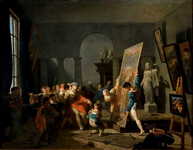An open-air auction in a town square
Landscape with an Aqueduct
Parade with Pierrot Scapin and Arlequin
Portrait of the Marquise of Belas
The Billiard Room

Preaching of Saint John the Baptist

Dona Carlota Joaquina, wife of King Dom João VI of Portugal, Brazil and Algarves

Country LandscapePortrait of the Marquise of Belas

Heroism of the sailors of the ship of the line Vengeur under captain Renaudin



Portrait of Infanta Maria da Assunção of Portugal (1805-1834)

Portrait of Maria Teresa of Portugal , wife of Carlos de Borbón, pretender to the Spanish throne.



Landscape in the Roman Campagna

View of Rio de Janeiro bay from the mountains in Tijuca

View of Beach and Knoll of Glory Church in Rio de Janeiro

Santo Antônio Hill, Rio de Janeiro

Death of Francesco Francia, in front of the "Saint Cecilia" of Raffaello Sanzio



Portrait of Félix-Émile Taunay








View from the Outeiro, the beach and the Church of Glória

Carioca Square, Rio de Janeiro


Portrait of Dom António, Prince of Beira (1795-1801)

Parade with Pierrot, Scapin and Arlequin

Portrait of Gerard van Spaendonck

Fine Art Prints | Greeting Cards | Phone Cases | Lifestyle | Face Masks | Men's , Women' Apparel | Home Decor | jigsaw puzzles | Notebooks | Tapestries | ...
A landscape with Ruth and Boaz on a path in the foreground
Nicolas-Antoine Taunay (10 February 1755 – 20 March 1830) was a French painter.
Early years
Nicolas Antoine Taunay was born in Paris, France, in 1755. His father was an enamel painter.
Taunay
entered the École des Beaux-Arts in Paris at the age of fifteen and
became a pupil of Nicolas-Bernard Lepicié (1735-1784). He later studied
in the studios of Nicolas-Guy Brenet (1728-1792) and Francesco Giuseppe
Casanova (c. 1732-1803).[1] He specialized in painting landscapes.
Taunay first exhibited his work at the Jeunesse and Salon de la
Correspondance. In 1784 he was admitted as an assistant at the Royal
Academy of Painting and Sculpture. He was now able to exhibit at
official shows.[2] Taunay obtained a three-year scholarship to study at
the French Academy in Rome in the Palazzo Mancini. While in Italy he
met the artist Jacques-Louis David (1748 - 1825).
After
returning to France in 1787 Taunay exhibited in the Paris Salon.[2] He
married Josephine Rondel (1768-1844) soon after his return. They had
six children, one of them being the also painter Félix Taunay, the
father of French-Brazilian author Alfredo d'Escragnolle Taunay. He
lived with his family in Montmorency, Val-d'Oise, during the Reign of
Terror (1793-1794).[1] He returned to Paris in 1796 and joined the
newly formed Institut de France. In 1805 he painted scenes of
Napoleon's campaigns in Germany.[2] In 1806 he started contributing
work to the Manufacture de Sévres. The Empress Josephine commissioned
many paintings of battle scenes from him.[1]
Brazil
Portrait of the Marchioness of Belas (1816)
After
the fall of Napoleon Taunay moved to Brazil as a member of the Missão
Artística Francesa (French Artistic Mission), funded by King John VI of
Portugal.[2] The Missão Artística Francesa was organized by Joachim
Lebreton. He had brought a group of artists to Brazil, arriving in Rio
de Janeiro on 25 March 1816. These included the painter Jean-Baptiste
Debret (1768–1848), Nicolas's brother the sculptor Auguste Marie Taunay
(1768–1824), the engraver Charles-Simon Pradier (1786–1847) and the
architect Auguste-Henri-Victor Grandjean de Montigny (1776–1850). They
were to form the nucleus of a royal art academy in Brazil.[3]
Nicolas-Antoine
Taunay became a member of the Royal School of Sciences, Arts and
Trades, later to become the Imperial Academy of Beaux-Arts, as
professor of landscape painting.[2]
The arrival of the
French group caused some controversy among the local Portuguese
intelligentsia, who were concerned at the excessive influence being
given to the French in developing the cultural life of Brazil. In turn,
the French were unhappy with political appointments such as the
appointment of Henrique José da Silva as head of the school in place of
Lebreton, who had died in 1819. For this reason, Nicolas-Antoine Taunay
returned to France in 1821.[4]
Nicolas-Antoine Taunay died
in 1830. During his lifetime he was considered one of the greatest of
the painters of the First French Empire. After his death he was soon
forgotten, although his work went through a revival in popularity in
the 1870s organized by the Goncourt brothers.[5]
Works
Although
his main interest was historical landscape painting, Nicolas-Antoine
Taunay was also a skilled painter of portraits and battle scenes. His
style reflects Dutch and classical French influences.[1]
References
Citations
Fahy 2005, p. 289.
Taunay, Nicolas Antoine: Itaú.
Williams 2001, p. 267.
Sadlier 2010, p. 112.
Lebrun & Taunay 2003, p. 5.
Sources
Fahy, Everett (2005-01-01). "Nicolas-Antoine Taunay". The Wrightsman
Pictures. Metropolitan Museum of Art. ISBN 978-1-58839-144-5. Retrieved
2014-02-17.
Lebrun, Claudine; Taunay, Nicolas
Antoine (2003). Nicolas-Antoine Taunay (1755-1830). ARTHENA,
Association pour la diffusion de l'histoire de l'art. ISBN
978-2-903239-36-7. Retrieved 2014-02-17.
Sadlier, Darlene J. (2010-01-01). Brazil Imagined: 1500 to the Present.
University of Texas Press. ISBN 978-0-292-77473-5. Retrieved 2014-02-15.
"Taunay, Nicolas Antoine (1755 - 1830)". Encyclopédie Itaú Cultural
arts visuels. 8 October 2013. Retrieved 2014-02-17.
Williams, Daryle (2001-07-12). Culture Wars in Brazil: The First Vargas
Regime, 1930–1945. Duke University Press. ISBN 0-8223-2719-8. Retrieved
2014-02-15.
----
Fine Art Prints | Greeting Cards | Phone Cases | Lifestyle | Face Masks | Men's , Women' Apparel | Home Decor | jigsaw puzzles | Notebooks | Tapestries | ...
----
Artist
A - B - C - D - E - F - G - H - I - J - K - L - M -
N - O - P - Q - R - S - T - U - V - W - X - Y - Z
Retrieved from "http://en.wikipedia.org/"
All text is available under the terms of the GNU Free Documentation License








